July 30, 2021 —
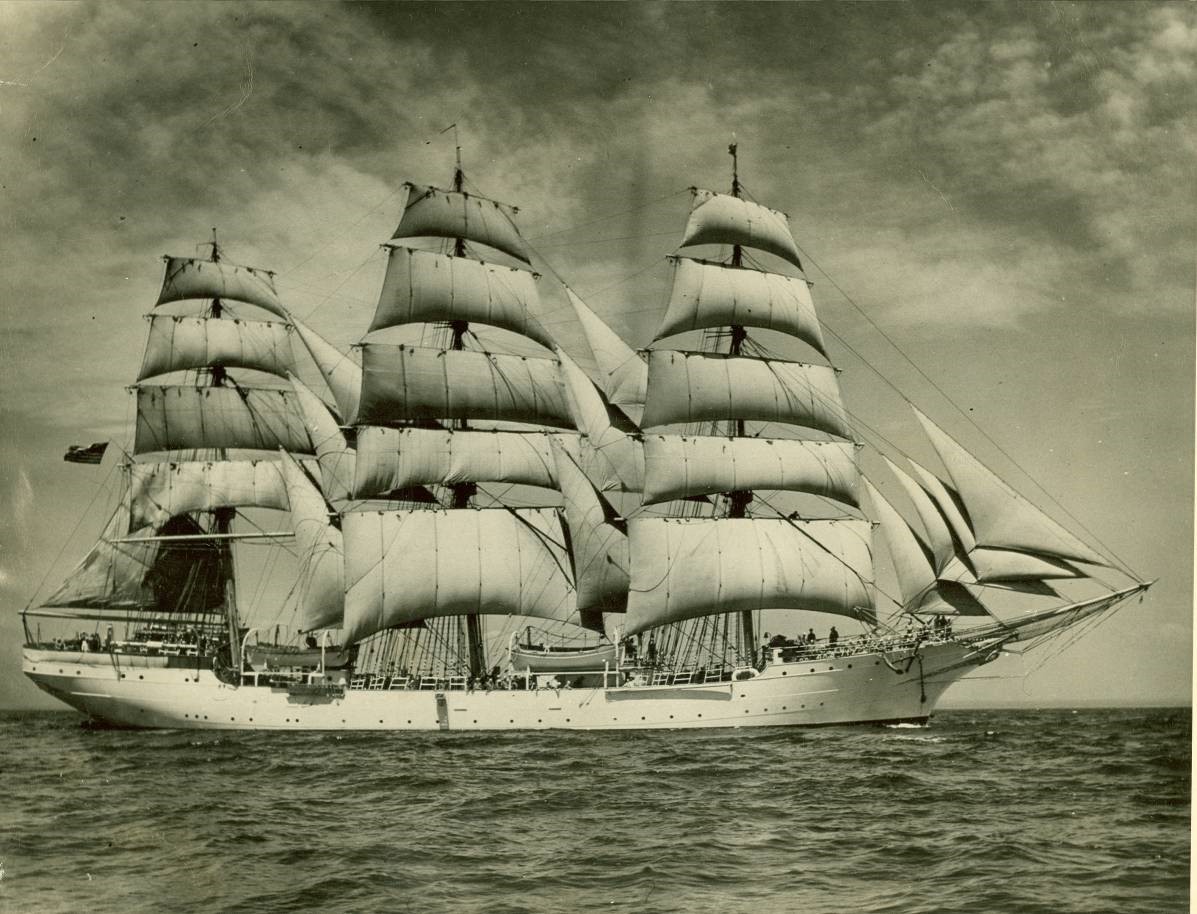 In the summer of 1939, war clouds were forming in Europe when Adolf Hitler sent warships to Poland and World War II began. European countries, including neutral Denmark, faced an
In the summer of 1939, war clouds were forming in Europe when Adolf Hitler sent warships to Poland and World War II began. European countries, including neutral Denmark, faced an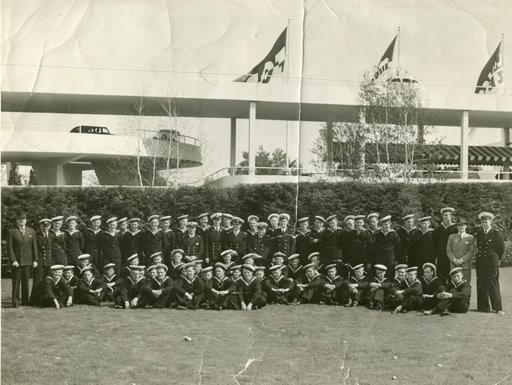 uncertain future. In New York, preparations were underway for the World’s Fair. Denmark was to send its largest naval ship, the Niels Jud, but the warship had to be pressed into active service. Instead, the sail training ship Danmark deployed for New York along with its crew and a full complement of Danish cadets. It would take six years before their ship returned home.
uncertain future. In New York, preparations were underway for the World’s Fair. Denmark was to send its largest naval ship, the Niels Jud, but the warship had to be pressed into active service. Instead, the sail training ship Danmark deployed for New York along with its crew and a full complement of Danish cadets. It would take six years before their ship returned home.
The Danmark left Copenhagen on Aug. 8, 1939, and sailed straight into the heart of the American public. Newspapers heralded the Danmark’s appearance at the World’s Fair. There was a Danish Cadets Day luncheon in its honor and New York’s mayor, Fiorello La Guardia, arranged for the crew to attend a New York Yankees baseball game. The ship’s next portcall was Annapolis, Maryland, arriving there Oct. 17 then stopping in the nation’s capital a week later. Danmark arrived in Puerto Rico Dec. 2 for a holiday season layover. On April 1, 1940, the ship docked in Jacksonville, Florida, and prepared to sail home.
On the morning of Sunday April 7, an elderly Finnish woman traveled by train from the Florida countryside to visit the Danmark. Capt. Knud Hansen found her very strange and later noted that a complete solar eclipse occurred the same day. He would recall the incident as a prophecy of what was to come. The woman began:
“Listen to what I say. Do not sail from here, Captain. Another eagle has cast its insatiable eye on your country. It has hissed its beak for a long time and will tear out from the breast your people’s heart. When it will happen, I do not know, but I have thought a lot about you and your men and your boys since you came to New York to the big World’s Fair and I have seen that you will not all return to Denmark. Do not let the eagle strike its claws into you and tear out your hearts. Remain where you are and fight against it until the day comes when its wings are clipped and you can sail home in peace.”
Two days later, Denmark was invaded by Germany. In Washington, Danish Ambassador Henrik Kauffmann turned away from the Nazi-backed regime installed in Denmark. Hansen had attended a farewell dinner for the Danmark and, on return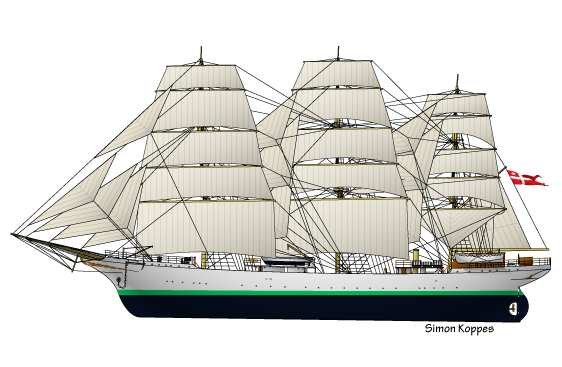 ing to the ship, he called the crew together. The men decided to remain in Jacksonville.
ing to the ship, he called the crew together. The men decided to remain in Jacksonville.
Anchored off the Coast Guard station in Jacksonville, Danmark became a ship without a country. The Danish Embassy in Washington arranged for a monthly stipend of $10 for the crew, but Danmark had no other support. On the morning of April 10, Hansen was greeted on the p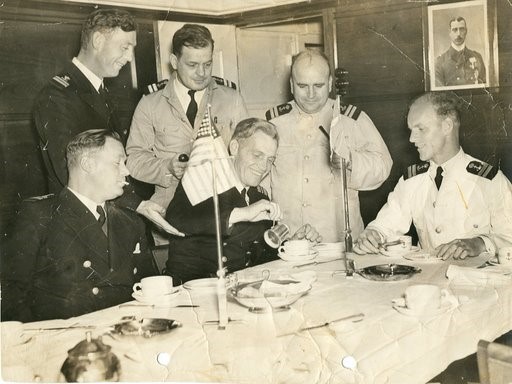 ier by a group of Jacksonville citizens and two large trucks. They brought 17 tons of food and supplies. Hansen did not turn them away, although there was no space on board for all of it. Each morning thereafter, women brought cookies and pies and men brought tobacco and other items. Even an anonymous shipment of summer uniforms arrived, much to the crew’s delight.
ier by a group of Jacksonville citizens and two large trucks. They brought 17 tons of food and supplies. Hansen did not turn them away, although there was no space on board for all of it. Each morning thereafter, women brought cookies and pies and men brought tobacco and other items. Even an anonymous shipment of summer uniforms arrived, much to the crew’s delight.
The Coast Guard had been looking for a training ship of its own ever since its vessel was badly damaged in the Great Hurricane of 1938. Vice Adm. Russell Waesche, Commandant of the Coast Guard, visited the Danmark in the summer of 1940. Waesche immediately recognized the ship’s potential and initiated paperwork to acquire it. The original plan was for the Danmark’s crew to transfer to the U.S. Merchant Marine and for the Navy to purchase the ship. Lacking a formal agreement, negotiations were postponed several times. Hansen entered into direct negotiations with Waesche, however, Denmark did not wish to sell or requisition the Danmark in fear of being vetoed by the Nazis.
The Danmark had become a foreign vessel lying idle in American waters. It had remained in Jacksonville from early April 1940 until late 1941, or nearly 20 months. Many of the ship’s Danish cadets decided to transfer to the Merchant Marine and 14 of them would die serving Allied forces. Ten of Danmark’s original crew remained aboard, including Hansen and First Mate Knud Langevad.
On June 17, 1941, Rear Adm. James Pine, superintendent of the Coast Guard Academy, recommended to the Academy’s Board of Visitors that the Danmark be purchased as a training ship. The United States offered to purchase the ship for $350,000 in the spring of 1941. This was half Danmark’s value and considerably less than the cost of building a similar ship. President Franklin Roosevelt felt that the offer was too high, so Denmark rejected the offer once again. Negotiations continued until Congress passed legislation allowing Danmark to remain under Danish control in American service.
Negotiations were still underway on the morning of Dec. 7, 1941, when Japan attacked Pearl Harbor, pushing the United States into the war. The next day, Hansen sent a tele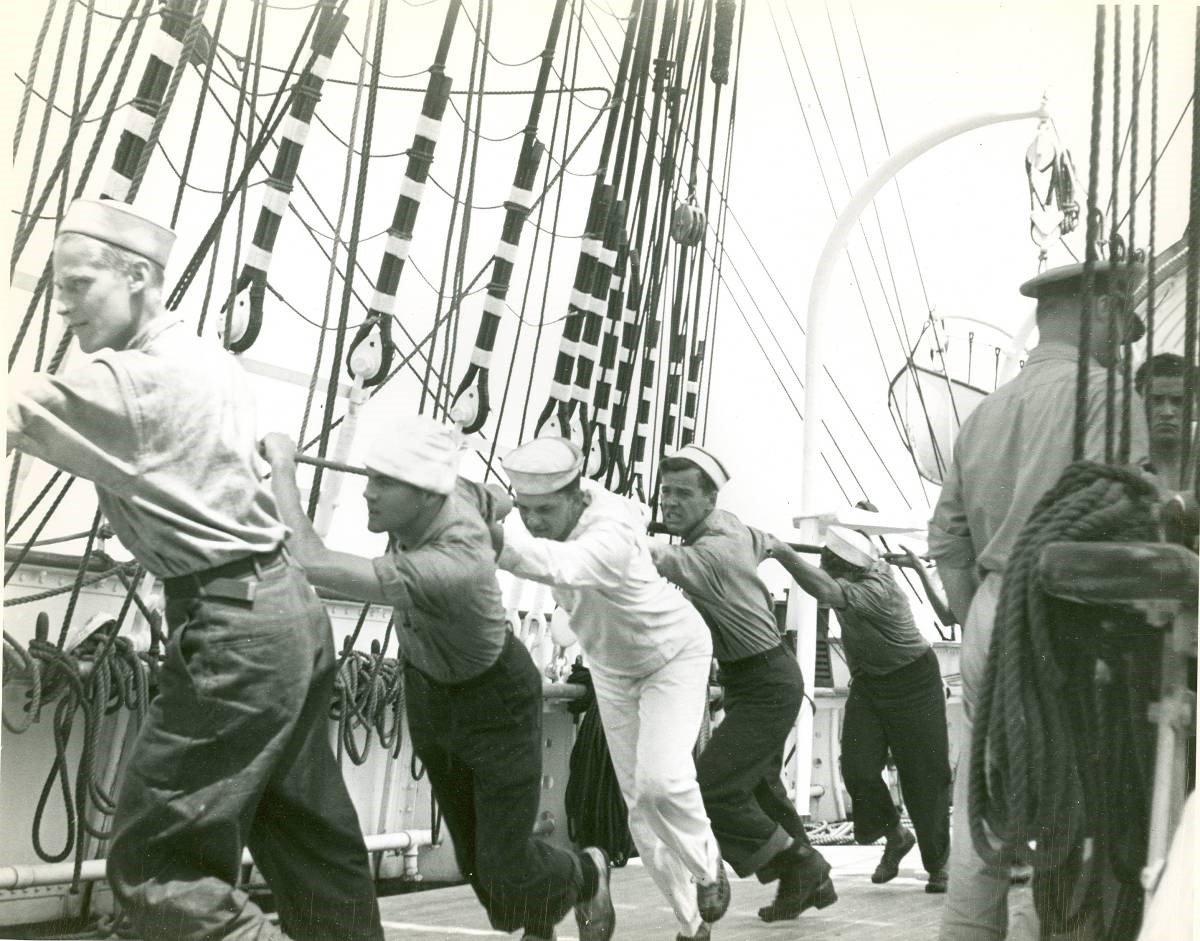 gram to Washington: “In view of the latest days’ developments, the cadets, officers, and captain of the Danish Government Training Vessel Danmark unanimously place themselves and the ship at the disposal of the United States government, to serve in any capacity the United States government sees fit in our joint
gram to Washington: “In view of the latest days’ developments, the cadets, officers, and captain of the Danish Government Training Vessel Danmark unanimously place themselves and the ship at the disposal of the United States government, to serve in any capacity the United States government sees fit in our joint 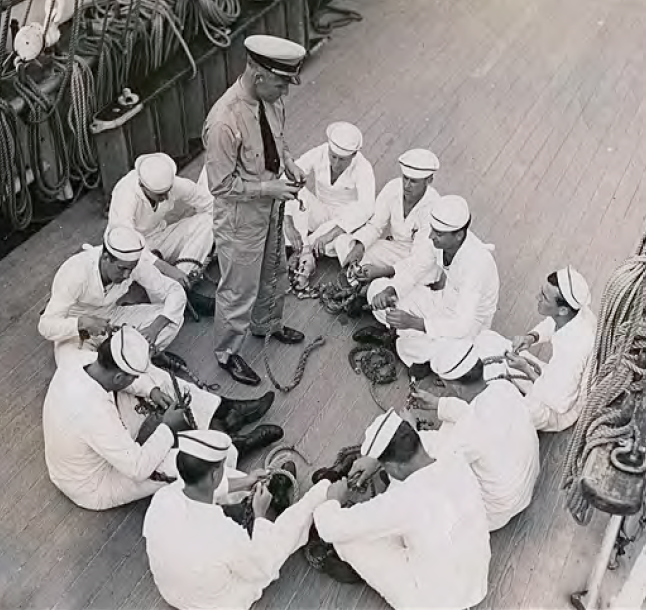 fight for victory and liberty.” Washington accepted the offer and a final agreement was signed Dec. 14.
fight for victory and liberty.” Washington accepted the offer and a final agreement was signed Dec. 14.
The Danmark was the only ship under the Danish flag outside of Nazi-occupied Denmark, thus it was legally considered an enemy ship sailing in foreign waters. A telegram was sent to the U.S. North Atlantic Command and permission granted Danmark to sail under the Danish flag with U.S. Navy escorts to the Coast Guard Academy. In early 1942, the U.S. flag was raised on the fantail of the Danmark. The State Department waived the stipulation that the ship’s officers be American citizens and the Danmark was commissioned a Coast Guard vessel in May 1942.
Each month, new Coast Guard cadets embarked Danmark for training. The Danish officers had many challenges before them–everything that a Danish cadet learned in six years, plus what he learned to qualify as a Danish navy officer, had to be taught the American cadets in four months. No American officers served aboard and, to avoid attack by U-boats, the tall ship never sailed beyond Martha’s Vineyard or the southern tip of Manhattan.
Few Coast Guard cadets left the Danmark without lifelong memories of the ship. Danmark’s classes were held below deck and included “rules of the road,” and “rope and ground tackle,” with an occasional foray into the instructor’s seafaring background. Hoisting the anchor was every cadet’s nightmare. It took approximately two dozen cadets to make some 200 revolutions around the anchor capstan, by pushing it around on its six bars.
In spite of Danmark’s auxiliary engine, Hansen trained only under sail and this is what Danmark became known for. He enjoyed practicing repeated man-overboard drills under sail. Hansen refused to run the auxiliary engine for training purposes. When returning to the Academy, he would sail up the Thames River through the old New London drawbridge to the Academy pier, back the sails to stop the ship, and send a boat to the pier carrying a mooring line.
Many of the Danmark’s American cadets remember First Mate Langevad as a man of patience and good humor. His lectures on nautical rules of the road amused cadets admonishing them not to take the right of way when a trawler was bearing do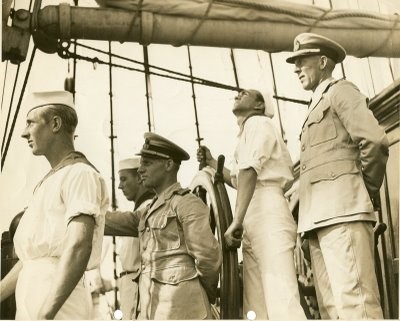 wn on their ship. Hoisting the yards and setting the sails to the shrill of Langevad’s bosun’s pipe was quite a feat. If the sails were not furled to perfection according to Langevad, he would exclaim, “What you got in there – the chief engineer?” This was the cue for the cadets to repeat the furling exercise until Langevad was satisfied. One cadet awoke Langevad to show how the cadet’s navigational plot had put the ship ashore in Massachusetts. Without saying a single word
wn on their ship. Hoisting the yards and setting the sails to the shrill of Langevad’s bosun’s pipe was quite a feat. If the sails were not furled to perfection according to Langevad, he would exclaim, “What you got in there – the chief engineer?” This was the cue for the cadets to repeat the furling exercise until Langevad was satisfied. One cadet awoke Langevad to show how the cadet’s navigational plot had put the ship ashore in Massachusetts. Without saying a single word or moving a muscle in his face, Langevad showed that the cadet had applied steering compass deviation to the standard compass, then he yawned and went back to sleep.
or moving a muscle in his face, Langevad showed that the cadet had applied steering compass deviation to the standard compass, then he yawned and went back to sleep.
Cadets were required to climb to the top of the masts nearly 150 feet up and then down to the other side. Not all cadets were eager to do this. One of the Danish crew would take a belaying pin out of the fife rail, hit a stay just below a cadet’s feet and say firmly, “You VILL go up.” The Dane then climbed the rigging, leaving the cadet with no choice but to go up. In winter, cadets were not even permitted to wear gloves while climbing the rigging.
Dubbed the “Dirty D”, cadets scrubbed the Danmark at least three times a day with rainy days devoted to cleaning out lifeboats and sanding oars. The wheelhouse was varnished frequently. It was lights out at midnight when the ship’s generator shut off. If the last liberty boat returned late to the Danmark, the cadets had to undress, sling out hammocks and climb into the hammocks in total darkness.
On Sept. 26, 1945, at Hansen’s request, Danmark’s official decommissioning ceremony took place on Danish King Christian X’s birthday. The Coast Guard Academy presented Danmark with a bronze plaque, which remains on board today. Tributes to the ship’s officers were given by several dignitaries, including the governor of Connecticut. Next, Danmark’s executive officer read the orders of decommissioning. The U.S. flag was lowered while the Star Spangled Banner played and then the Dannebrog was raised to the notes of the Danish national anthem. In December 1946, the Danmark set out on its last training cruise stopping at various American ports before sailing home.
During the war, Danmark had trained over 5,000 American cadets and 60% of them received officer commissions in the Coast Guard or the U.S. Navy. During Operation Sail (OpSail) events in the U.S., the Eagle always sailed first in line, being the host country’s premier tall ship. Right behind it sailed the Danmark, a nod to the ship’s role in Coast Guard history. That has remained an OpSail tradition since the event’s establishment in 1964.